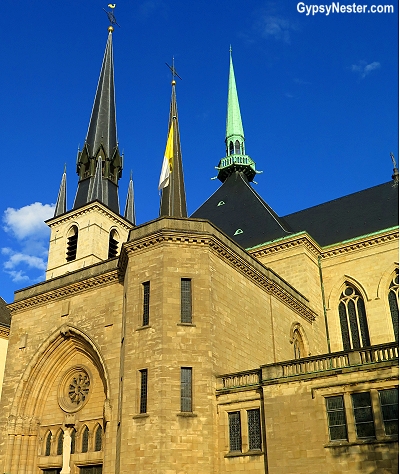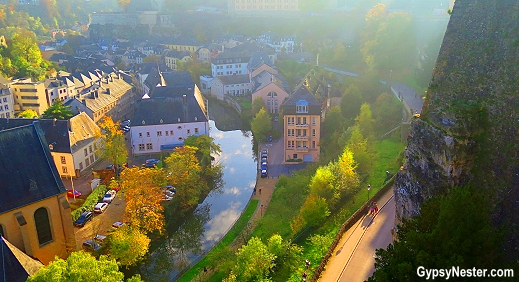Thanks to Viking River Cruises for inviting us along and providing this adventure! As always, all opinions are our own. See our entire sailing here.

As Europe’s richest country, and ranked second in the entire world, it was easy for us to think that the luxe in Luxembourg would stem from the same source as deluxe, or luxury, but it doesn’t.
The name comes from lucilem, the Celtic word for little, and burg, German for castle. The combination perfectly reflects this tiny crossroads nation’s long history of being set between much larger powers.

Slightly smaller than Rhode Island, Luxembourg is one of the smallest countries in Europe, and is surrounded by France, Belgium, and Germany.
Over the centuries she has managed to navigate between her neighbors to remain the world’s last grand duchy, meaning that she is ruled by a grand duke.


Through the diplomacy and royal relationships of the dukes, and the strategic placement of its namesake castle, Luxembourg has not only survived, but flourished.
As we entered Luxembourg City the fortifications certainly didn’t look to be small at all, but then the name refers to the original Castle of Lucilinburhuc from back in the year 963. There have been significant upgrades since then.
In fact, over time, the city has become one big honkin’ fortress. Walking inside the walls, we got a glimpse of what life looked like centuries ago.

Space was at a premium within the ramparts, so the streets are narrow and homes crowded together.
Down one little lane we noticed an arch inside a tiny courtyard displaying crossed arrows above the doorway, and our guide explained how the sign was thought to help avoid the plague during rampant outbreaks.

The sores incurred from the dreaded disease looked a lot like arrow wounds and, while we doubt the ploy was effective, we certainly understand the need for grasping at straws arrows.
We’d have been all over any plague-avoidance tactics.
 One thing the city had no trouble keeping away was invaders.
One thing the city had no trouble keeping away was invaders.
Much of the fortification was natural, as we saw when we walked along the Chemin de la Corniche.
This walkway was built atop the ramparts on the massive cliffs of the Alzette valley in the 17th century, adding to Luxembourg’s already impressive defenses.
We could almost hear the city’s founders exclaiming their delight when finding this spot, what a perfect place from which to drop flaming oil on our enemies’ heads!

The lookout along the walkway is often called the most beautiful balcony in Europe, and the view makes it easy to see why Luxembourg was once known as the Gibraltar of the North.

An assault would have been nearly impossible since the city had the luxury of practically perfect protection on three sides.


Back in the center, of town we wandered around the main square and discovered a veritable smörgåsbord of languages.
Luxembourg’s location makes for an interesting buffet of both spoken and written words.
While most of the signs around town are lettered in French, official business is conducted in Luxembourgish, French, and German. Wandering around we overheard dozens of languages, and sitting at a sidewalk café in the main square became a linguistic feast.

Staff and customers alike switched between tongues without missing a beat, mixing it up in the same conversation, even the same sentences.
Playing off the term Spanglish, we dubbed these phenomena Gerfranbourgish (we also giggled over Luxemgermench and Franluxerman – that was a really fun lunch!)

We also happened upon what claims to be the oldest pub in Luxembourg, dating back to 1691.
We knew this because they proudly announced it in multiple languages on a sign out front.
Honestly, we appreciated the sign more for providing a peek into some translations than its informative properties, but we give big snaps for embracing the local diversity of speaking.
Lest we forget, the American Cemetery

Just outside the city, at Hamm, we briefly returned to the United States when we visited the hallowed ground of the Luxembourg American Cemetery and Memorial, which is officially American soil.
Luxembourg presented the land to the US in perpetuity in appreciation for helping free the country from Nazi occupation.


In 1939, Luxembourg declared itself neutral as war broke out. Germany had other ideas, invading on May 10, 1940, then occupying the country and sending the duke and government into exile.
Two years later, the Third Reich formally annexed the duchy and declared Luxembourgers to be German citizens. At that point they began drafting thousands of men to fight in the war.

Strict rules — including a ban on speaking French — were imposed. A resistance movement formed, but opposition to German rule was severely punished.
Passive resistance was most common, with refusing to speak German at the top of the list. Many Luxembourgers returned to the old Luxembourgish, and, in the process, most likely saved the language from disappearing.
U.S. forces liberated Luxembourg in September 1944, but were almost immediately engaged in the Battle of the Bulge and parts of the country fell back into German hands.
The allies ultimately prevailed, which was instrumental in ending World War II, and many of the soldiers who lost their lives in that combat are buried at the Luxembourg American Cemetery.

We somberly walked the grounds where over five thousand soldiers are interred.
One of them is General George S. Patton, who survived the battle only to perish in an automobile accident a few months later.
He was originally buried alongside his troops, but in an effort to keep the surrounding graves from being trampled, he was moved to the forefront of the site.

As we were leaving, we met the cemetery superintendent, Scott DeJardins, who lives at the site.
He explained to us that because of the unique position of this — and the many other United States Military Cemeteries around the world — as American territory, there is always an American caretaker.

Mr. DeJardin is happily serving his fifth assignment in the last nine years, and is headed to Normandy next.
It’s a job he clearly loves, in fact he said “I’d tell my boss I’d do it for free, but I’m afraid he might take me seriously.”
A welcome bit of levity in our very solemn visit.
With our explorations of Luxembourg complete, we took to heart an old saying.
Big things do come in small packages.
David & Veronica, GypsyNester.com
Thanks to Viking River Cruises for inviting us along and providing this adventure! As always, all opinions are our own. See our entire sailing with stops in Paris, Luxembourg, Trier, Cochem, Heidelberg, Wurzburg, Rothenburg, Nuremberg, and Prague.



My husband Syl and I visited Luxembourg four times and each time it was a wonderful experience, we met a lot of nice people and friends.
We belonged to the Luxembourg Society Located at Belgium, Wisconsin.
My husband worked with the Luxembourg Masons and Carpenters rebuilding The Sinnen House at Pioneer Village in Ozaukee, County.
My husband Syl and I visited many places in Luxembourg and met many new friends. He worked with the Luxembourg Masons and Carpenters re building the Sinnen House at Pioneer Village in Ozaukee County To the west of Belgium,Wisconsin.
We belonged to the Luxembourg Society of Wisconsin for many years and cherished our four visits to Luxembourg We always rented a car and drove and saw many interesting sites.
I had no idea the American Cemetery in Luxembourg was so beautiful. Thank you for introducing me to it.
What is the connection between the Luxembourg and Prague in the Czech Rep.Well it is King Charles IV the Holy Roman Emperor, whose father was King John of Luxembourg, and that is why Charles IV has a French education, and would partly explain why he extended the cultivation of wine in Prague ., even as far as creating the Prague disctrict of Vinohrady, which means the Wineyards.
Thanks for the great introduction to Luxembourg, guys. I’m headed there myself on a Viking cruise, and after reading this I’m looking forward to it even more. The language smorgasbord in Luxembourg sounds a lot like what I found in Belgium: I was really impressed with how easily they switched from one language to the other. Amazing what the human mind can do.
Enjoy your trip Paul, you’re right, Belgium is also a crossroads for languages.
I’ve never been to Luxembourg but next time I”m in the area I think I’ll do them the favor of a visit! 🙂 I love your humor but beg to differ that the man keeping out the plague could have actually scared “the pants” off of at least me! Maybe something else but definitely not my pants!
Thanks Kay! Perhaps you are who the saying “keep your pants on” is about. 😉
Great piece on Luxembourg. We literally passed through one night and just had dinner. I had know idea their was an American Cemetery so near by and so many other sites to visit. We’ll definitely have to visit again and during the day!
Thanks Sue! It’s worth another look.
I’ve visited Luxembourg several times but managed to miss most of the sites. I enjoyed seeing them through your post. Next time I visit, I am definitely going to that old pub.
We went through pretty quickly ourselves. Definitely worth another visit.
I was in Luxembourg in September. Your descriptions and photos brought back great memories. BTW, I just ordered your book. Can’t wait to read it!!
Always glad to bring memories, and thanks Marilyn, let us (and maybe Amazon or Barns & Noble) know what you think of it. 😉
I want to visit Luxembourg, spend every minute of my stay wide awake. I want to walk slowly along the streets, and visit every shop. I want to wave to as many people as possible. I want to be a good New Englander ambassador.
Now doesn’t Luxembourg look quite wonderful! They must be proud to be the richest country in Europe :-). Probably a very nice place to live!
You’ve given me a nice education on Luxembourg 101. Having never been there, I learned so much from your post!
Thanks Irene!
I had no idea that Luxembourg was Europe’s richest country!!! Thx for that info, and for sharing your wonderful pics! I hope I will get there in the future. I wonder if they make good chocolate???
We didn’t try any chocolate, but I’ll bet there is some good stuff.
So sweet to see the old town has retained its scale and character. I look forward to a long visit in the region one day.
It’s been too long since I’ve visited this country, walking along the fortifications of most cities end up being one of my favorite pass times because the views are always spectacular
Good point Noel, they certainly were here.
Great photos of Luxembourg. I didn’t know they had their own language. Amazing Luxembourgish survives in such a small country.
Thanks Shelly! Pretty cool, huh?
We’ve decided we want to see all the little European countries after visiting Liechtenstein last year. Luxembourg looks wonderful. Back in the day there was a trader from Luxembourg in my ex’s company who was learning the craft at the LA stock exchange before returning to his banking heritage. It’s really amazing how much wealth there is in these little places.
Luxembourg was instrumental in bringing together the EU and has profited from that.
The photos and descriptions make Luxembourg look like a very interesting place to visit. I’ve never been. Maybe some day.
Luxembourg is indeed a wonderful place to visit. It’s been almost 40 years and now you’ve made me want to go back!
Bet it hasn’t changed all that much, it remains a classic.